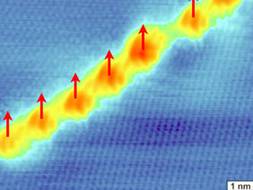Home > Press > Graphite mimics ironís magnetism
 |
| The electron density of states on a grain boundary of defects. The arrows (pointing in the readerís direction) indicate the direction of the magnetic moments |
Abstract:
Researchers at Eindhoven University of Technology show for the first time why ordinary graphite is a permanent magnet at room temperature. The results are promising for new applications in nanotechnology, such as biosensors and detectors. The findings were published online in Nature Physics.
Graphite mimics ironís magnetism
Netherlands | Posted on October 5th, 2009Graphite is a well-known lubricant and forms the basis for pencils. It is a layered compound with a weak interlayer interaction between the individual carbon (graphene) sheets. Hence, this makes graphite a good lubricant.
Unexpected
It is unexpected that graphite is ferromagnetic. The researchers Jiri Cervenka and Kees Flipse (Eindhoven University of Technology) and Mikhail Katsnelson (Radboud University Nijmegen) demonstrated direct evidence for ferromagnetic order and explain the underlying mechanism. In graphite well ordered areas of carbon atoms are separated by 2 nanometer wide boundaries of defects. The electrons in the defect regions (the red/yellow area in picture 1) behave differently compared to the ordered areas (blue in picture 1), showing similarities with the electron behaviour of ferromagnetic materials like iron and cobalt.
Debate settled
The researchers found that the grain boundary regions in the individual carbon sheets are magnetically coupled, forming 2-dimensional networks (picture 2). This interlayer coupling was found to explain the permanent magnetic behaviour of graphite. The researchers also show experimental evidence for excluding magnetic impurities to be the origin of ferromagnetism, ending ten years of debate.
Carbon in spintronics
Surprisingly, a material containing only carbon atoms can be a weak ferro magnet. This opens new routes for spintronics in carbon-based materials. Spins can travel over relative long distances without spin-flip scattering and they can be flipped by small magnetic fields. Both are important for applications in spintronics. Carbon is biocompatible and the explored magnetic behaviour is therefore particularly promising for the development of biosensors.
Publication Nature Physics
The paper in Nature Physics " Room-temperature ferromagnetism in graphite driven by 2D networks of point defects" by Jiri Cervenka, Mikhail Katsnelson and Kees Flipse appeared online Sunday 4 October, 7:00 pm CET. The paper can be found under DOI 10.1038/NPHYS1399.
The research was funded by Nanoned and FOM.
####
For more information, please click here
Contacts:
Kees Flipse
phone +31 40 - 247 4118
General questions:
press officer
Jim Heirbaut
+31 6 - 4194 2160
Copyright © Eindhoven University of Technology
If you have a comment, please Contact us.Issuers of news releases, not 7th Wave, Inc. or Nanotechnology Now, are solely responsible for the accuracy of the content.
| Related News Press |
News and information
![]() Simulating magnetization in a Heisenberg quantum spin chain April 5th, 2024
Simulating magnetization in a Heisenberg quantum spin chain April 5th, 2024
![]() NRL charters Navyís quantum inertial navigation path to reduce drift April 5th, 2024
NRL charters Navyís quantum inertial navigation path to reduce drift April 5th, 2024
![]() Discovery points path to flash-like memory for storing qubits: Rice find could hasten development of nonvolatile quantum memory April 5th, 2024
Discovery points path to flash-like memory for storing qubits: Rice find could hasten development of nonvolatile quantum memory April 5th, 2024
Spintronics
![]() Quantum materials: Electron spin measured for the first time June 9th, 2023
Quantum materials: Electron spin measured for the first time June 9th, 2023
![]() Linearly assembled Ag-Cu nanoclusters: Spin transfer and distance-dependent spin coupling November 4th, 2022
Linearly assembled Ag-Cu nanoclusters: Spin transfer and distance-dependent spin coupling November 4th, 2022
Sensors
Discoveries
![]() Chemical reactions can scramble quantum information as well as black holes April 5th, 2024
Chemical reactions can scramble quantum information as well as black holes April 5th, 2024
![]() New micromaterial releases nanoparticles that selectively destroy cancer cells April 5th, 2024
New micromaterial releases nanoparticles that selectively destroy cancer cells April 5th, 2024
![]() Utilizing palladium for addressing contact issues of buried oxide thin film transistors April 5th, 2024
Utilizing palladium for addressing contact issues of buried oxide thin film transistors April 5th, 2024
Announcements
![]() NRL charters Navyís quantum inertial navigation path to reduce drift April 5th, 2024
NRL charters Navyís quantum inertial navigation path to reduce drift April 5th, 2024
![]() Discovery points path to flash-like memory for storing qubits: Rice find could hasten development of nonvolatile quantum memory April 5th, 2024
Discovery points path to flash-like memory for storing qubits: Rice find could hasten development of nonvolatile quantum memory April 5th, 2024
|
|
||
|
|
||
| The latest news from around the world, FREE | ||
|
|
||
|
|
||
| Premium Products | ||
|
|
||
|
Only the news you want to read!
Learn More |
||
|
|
||
|
Full-service, expert consulting
Learn More |
||
|
|
||








